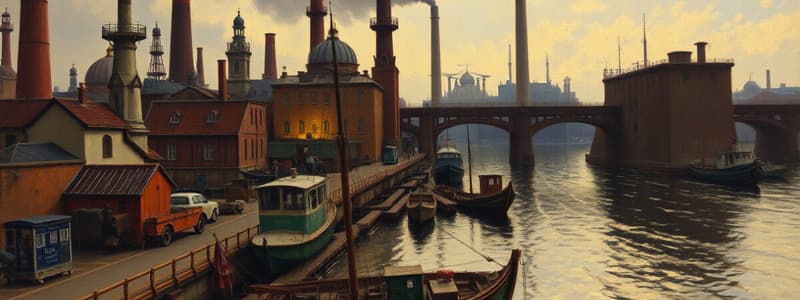Podcast
Questions and Answers
What was a significant outcome of the shift from agrarian to industrial economies?
What was a significant outcome of the shift from agrarian to industrial economies?
- Elimination of domestic trade networks
- Rise of factory systems and mass production (correct)
- Decrease in production efficiency
- Reduction in urban migration
Which technological invention significantly impacted textile production?
Which technological invention significantly impacted textile production?
- Telegraph
- Steam Engine
- Cotton Gin
- Spinning Jenny (correct)
What was one of the primary social changes resulting from industrialization?
What was one of the primary social changes resulting from industrialization?
- Decrease in urban populations
- Reduction in literacy rates
- Increased emphasis on family-based production
- Emergence of a new industrial middle class (correct)
What key demand was commonly associated with labor movements during the industrial era?
What key demand was commonly associated with labor movements during the industrial era?
Which innovation improved long-distance communication during the industrial period?
Which innovation improved long-distance communication during the industrial period?
What was a notable effect of urbanization during the industrial period?
What was a notable effect of urbanization during the industrial period?
Which significant event is associated with labor strikes in the late 19th century?
Which significant event is associated with labor strikes in the late 19th century?
What was a consequence of the industrial era on wealth distribution?
What was a consequence of the industrial era on wealth distribution?
What was one significant technological advancement in railroad development?
What was one significant technological advancement in railroad development?
How did railroads contribute to economic growth during the industrial era?
How did railroads contribute to economic growth during the industrial era?
What was a major impact of rail transport on commuting patterns?
What was a major impact of rail transport on commuting patterns?
Which social effect was a direct result of the expansion of railroads?
Which social effect was a direct result of the expansion of railroads?
In what way did rail transport influence global expansion?
In what way did rail transport influence global expansion?
What economic benefit did the standardization of track gauges provide?
What economic benefit did the standardization of track gauges provide?
What role did railroads play in shaping urbanization patterns?
What role did railroads play in shaping urbanization patterns?
What change in labor patterns occurred due to the expansion of railroads?
What change in labor patterns occurred due to the expansion of railroads?
Study Notes
Impact On Economy
- Shift from agrarian economies to industrial economies.
- Increased production efficiency and output due to mechanization.
- Rise of factory system, leading to mass production.
- Expansion of domestic and international trade networks.
- Growth of urban centers as people moved for jobs.
- Emergence of new economic theories (e.g., capitalism, socialism).
- Increase in wealth disparity between industrialists and laborers.
Technological Innovations
- Key inventions:
- Spinning Jenny: Increased textile production capacity.
- Steam Engine: Revolutionized transportation (trains, ships) and factory operations.
- Power Loom: Enhanced textile manufacturing speed and efficiency.
- Cotton Gin: Streamlined cotton processing, boosting the textile industry.
- Telegraph: Improved long-distance communication.
- Development of the iron and steel industries.
- Advancements in transportation infrastructure (railways, canals).
- Introduction of assembly line techniques in manufacturing.
Social Changes
- Urbanization: Rapid growth of cities due to migration from rural areas.
- Changes in living conditions: Overcrowded housing, sanitation issues, and pollution.
- Rise of a new social class: The industrial middle class (bourgeoisie).
- Emergence of the working class (proletariat), often facing poor working conditions.
- Changes in family structure: Shift from family-based production to wage labor.
- Increased literacy rates due to demand for skilled workers.
- Development of new social ideologies (e.g., socialism, labor rights).
Labor Movements
- Formation of labor unions to advocate for workers' rights and better conditions.
- Key demands included:
- Fair wages and shorter working hours.
- Safe working conditions and health benefits.
- The right to organize and collectively bargain.
- Major strikes and protests (e.g., Haymarket Riot, Pullman Strike).
- Legislative changes resulting from labor movements, leading to labor laws.
- Influence of prominent labor leaders and movements (e.g., Knights of Labor, American Federation of Labor).
- Growth of socialist and communist ideologies in response to capitalist exploitation.
Impact On Economy
- Transition from agrarian to industrial economies transformed production methods and economic structures.
- Mechanization enhanced production efficiency, significantly increasing output across various industries.
- The factory system emerged, enabling mass production of goods, which catered to growing consumer demand.
- Domestic and international trade networks expanded, facilitating greater access to markets and goods.
- Urban centers experienced rapid growth as individuals migrated in search of employment opportunities in factories.
- New economic theories developed, notably capitalism and socialism, responding to the dynamics of industrialization.
- Wealth disparity intensified, creating a divide between industrialists who profited and laborers who worked under challenging conditions.
Technological Innovations
- Key inventions revolutionized various sectors, beginning with the Spinning Jenny, which significantly boosted textile production.
- The Steam Engine transformed transportation and factory operations, laying the groundwork for modern logistical systems.
- The Power Loom improved the speed and efficiency of textile manufacturing, enhancing the production process overall.
- The Cotton Gin revolutionized cotton processing, subsequently boosting the textile industry’s growth and profitability.
- The Telegraph advanced long-distance communication, linking disparate regions and facilitating quicker exchanges.
- The iron and steel industries saw development, crucial for infrastructure and manufacturing expansion.
- Transportation infrastructure expanded with railways and canals, enhancing connectivity and trade.
- Assembly line techniques were introduced in manufacturing, streamlining production and reducing labor costs.
Social Changes
- Urbanization spurred rapid city growth as populations shifted from rural areas to urban centers.
- Living conditions became challenging, characterized by overcrowded housing, inadequate sanitation, and pollution.
- A new social class, the industrial middle class (bourgeoisie), emerged, gaining economic and political influence.
- The working class (proletariat) formed, often enduring poor working conditions and limited rights.
- Family structures evolved from family-based production systems to reliance on wage labor in industrial settings.
- Literacy rates increased, driven by the demand for skilled workers in growing industrial sectors.
- New social ideologies emerged, focusing on socialism and labor rights, reflecting the changing dynamics of society.
Labor Movements
- Labor unions were established to promote workers' rights and advocate for better working conditions.
- Key demands from unions included fair wages, shorter working hours, and safe working environments.
- The right to organize and collectively bargain became focal points in labor movements.
- Major strikes and protests, such as the Haymarket Riot and Pullman Strike, highlighted workers' struggles.
- Legislative changes arose in response to labor movements, leading to the establishment of labor laws.
- Prominent labor leaders and organizations, including the Knights of Labor and the American Federation of Labor, played significant roles.
- The rise of socialist and communist ideologies was a direct response to perceived capitalist exploitation in society.
Technological Advancements
- Steam locomotives significantly changed train travel dynamics, offering faster and more efficient transportation.
- Iron and steel development led to stronger tracks and more durable engines, enhancing overall railroad safety and longevity.
- Innovations in signaling and scheduling systems increased operational safety and improved travel efficiency between stations.
- Standardized track gauges allowed for seamless travel across different regions, promoting extensive connectivity.
- Introduction of freight cars greatly improved cargo transport, enabling the transport of larger volumes and diverse types of goods.
Economic Impact
- Railroads catalyzed industrial growth by ensuring efficient movement of raw materials to manufacturing sites and finished goods to markets.
- The expansion of railroad networks allowed businesses to access larger customer bases, thus driving economic growth.
- Significant investments poured into railroad construction and maintenance created numerous jobs, bolstering local economies.
- Urbanization accelerated as railroads linked rural areas with cities, prompting population movements towards urban centers.
- Lower transportation costs from rail travel resulted in reduced prices for goods, benefiting consumers.
Transportation Changes
- The transition from horse-drawn carriages and canals to railroads marked a significant shift in transportation methods for people and goods.
- Increased travel speeds transformed commuting behaviors, allowing for greater distances to be covered efficiently.
- The development of a national and international rail network facilitated both domestic and global commerce.
- Enhanced reliability in cargo transportation minimized spoilage and delivery delays, boosting trade efficiency.
- Railroads encouraged suburban development by enabling workers to reside further from urban job centers, altering living patterns.
Social Effects
- Railroads played a crucial role in migration and settlement, allowing people to access previously remote areas.
- Access to diverse goods through rail transport contributed to the rise of a consumer culture, altering purchasing behaviors.
- Increased mobility due to rail travel fostered leisure activities and influenced social interactions and dynamics.
- Cultural exchanges flourished as railroads enabled the spread of ideas, traditions, and practices across different regions.
- Labor patterns shifted, with many workers commuting daily to urban jobs, transforming workforce dynamics.
Global Expansion
- Rail transport was integral to colonial expansion, facilitating efficient resource extraction from colonies.
- Countries heavily invested in railroads to improve connectivity and enhance trade routes, benefiting their economies.
- The spread of railroad technology significantly impacted global trade networks, altering economic landscapes.
- Major projects like the Transcontinental Railroad connected vast regions, promoting national unity and economic integration.
- Railroads significantly contributed to the globalization of trade and industry during the 19th century, reshaping economic relationships.
Studying That Suits You
Use AI to generate personalized quizzes and flashcards to suit your learning preferences.
Description
Explore the transformative effects of the Industrial Revolution on the economy, including the shift from agrarian to industrial systems and the rise of new economic theories. Learn about key technological innovations that fueled mass production and expanded trade networks, as well as their implications for urban growth and wealth disparity.




